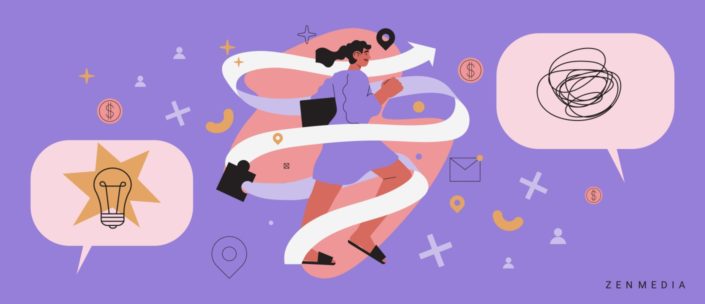The “Messy Middle” may sound like a 2000s sitcom, but it is actually one of the best ways for marketers to understand the buying journey of consumers. Traditionally, the “messy middle” diagram, as described by Google, looks a bit like an infinity loop with two exit points: triggers and purchase.
Of course, every brand would like all of their potential customers to exit the loop and make a purchase, but we have accepted that the purchase journey isn’t quite that linear. How do consumers enter the seemingly infinite loop anyway? Well, most likely, they’re already in one, or two, or many—the moment a consumer begins to consider a purchase, they’ve entered the loop, most likely on the exploration side of the journey.
During their purchase journey, a consumer is either expanding (exploring) their options or narrowing (evaluating) them. And the frustrating fact for marketers is that consumers can and likely will loop between the two modes of thinking a number of times before making a decision and converting (or not). As they loop, online resources like search engines, social media, and review websites help to inform their decisions.
Here at Zen Media, our Dark Social Model looks fairly similar to the traditional messy middle diagram, but it differs in an important way: it actually leaves space for the mess in the middle. Because, as our model shows, the messy middle is where shared, paid, earned, and owned media meet to interact with the consumer.
This is important because consumers need more touchpoints than ever before to make a purchase decision, and many of the opportunities for those touchpoints occur in this unquantifiable and untrackable area (we warned you that it was messy) called Dark Social—hence the name of the model.
What really happens in the messy middle?
In short: the bulk of your potential buyer’s purchase journey.
It may seem disheartening to have so little control over your consumer’s purchase journey, but there are plenty of ways for brands to position themselves to be not only discoverable to potential consumers but also to allow consumers to become familiar with the brand.
Because the messy middle includes a consumer’s own research, conversations, and interactions on dark social as well as engagement with your brand (and many others), it is important to instill a frequency bias in your marketing.
A frequency bias—or frequency illusion—is like the “yellow car” illusion. The more you see yellow cars, the more likely you are to notice them. In marketing speak, if you comment on a brand’s Facebook post or read a company’s post on LinkedIn, you’re more likely to notice its logo and name popping up in different places. If you had never engaged with the brand in the first place, you probably wouldn’t notice it elsewhere.
We know that the more someone sees a brand, the more likely they are to trust that brand. And since we all have inherent biases that inform our decisions, brands must use the exploration and evaluation phases of the buyer’s journey to make an imprint on the consumer’s mind. This will help them create a positive bias that will, hopefully, get the buyer to convert.
How can brands create positive bias?
In Google’s large-scale shopping experiment, it prioritized six cognitive biases that influence consumers’ shopping behaviors. Those biases—including category heuristics; the power of now; social proof; scarcity bias; authority bias; and the power of free—were applied to real in-market shoppers simulating 310,000 purchase scenarios across a variety of industries. Google even included a fictional brand in each category, simulating a brand that shoppers would have no prior exposure to.
The results? Even the least-effective brand challenger, a fictional cereal, still won 28% of consumer preference against the established brand when it was loaded with perceived benefits—like strong reviews and an offer to receive 20% extra for free. In a more extreme case, a fictional car insurer won 87% share of consumer preference when loaded with benefits across all six cognitive categories.
Those benefits created a positive bias toward a fictional brand and, according to the data, would have acquired new consumers for the brand. When applied with thoughtful consideration of the consumer and their purchase journey, using behavioral science principles can help brands create a positive bias and create or maintain customer preference in the messy middle.
The Evolution of the Purchase Journey
The buyer’s journey is not as straightforward as it once was. In fact, we listed “The buyer’s journey is linear” as one of the top five myths marketers should stop believing.
Before we realized just how messy the buyer’s journey is, most of the focus for marketers was on the actual conversion. How can we get this consumer to convert? How can we make the sale? How can we close the deal? We were channeling the Glengarry Glen Ross—Always Be Closing—mentality.
And while marketing enables sales, we—as marketers—cannot narrow our focus to the end of the buyer’s journey because buyers aren’t making their decisions just at the point of conversion any more. They are decision-making throughout the messy process—in loop-dee-loops of thoughtful consideration. So if your brand isn’t actively in front of buyers (ahem, frequency bias) from the start, you won’t be visible enough to make it to the end of the journey. And once a buyer makes their decision (i.e., the purchase), you’ve lost your chance to compete. So, if you want to influence the purchase decision, you must be engaged throughout the entire journey.
According to Forrester, buyers need 27 touchpoints before they convert; that’s 10 more than just a few years ago. Since we know that the majority of these touchpoints happen in the messy middle, it’s important for brands to understand how to make those touchpoints happen without being able to track each individual buyer’s journey.
So… how do you do that?
By getting your name out there and in front of the right people across a variety of platforms. This can look like using PPC ads to find your audience and direct them to your website. It can be getting PR coverage in relevant trade publications or building a strong following on social media. Or it can be having an amazing website with highly SEO-optimized content, so it’s always on the first page of Google.
Best case scenario? It’s all of the above.
Using a multi-faceted strategy, marketers can increase their brand’s share of voice, audience reach, and domain authority, therefore increasing the potential for conversion.
This means having your message in front of the eyes of your buyers from the moment they enter the buyer’s journey through to the moment they make their decision.
But what metrics do we track?
For the mess of engagement, research, exploration, and consideration that occurs in dark social—you don’t (mostly). That’s the whole point of the messy middle. Just because you can’t measure your consumer’s interactions with your brand doesn’t mean they aren’t engaged. Measuring clicks, open rates, and social metrics may provide some interesting numbers here and there, but they won’t enable you to see what’s happening in dark social interactions. But in a world where marketers have so much data, it feels a bit wrong to not have some metric to track doesn’t it?
In a sense, dark social is taking us back to pre-internet age—a time when brands didn’t have the capability to track how potential customers were interacting with their content (paper ads, radio spots, and maybe some billboards or TV commercials). Office watercoolers and family dinner tables witnessed a slew of exchanges, discussions, and decisions—but unless a marketer was hiding under the dinner table or behind the stylish office fern, the marketing team was none-the-wiser. Sound familiar? Dark social is not all that different from these kinds of untrackable conversations that consumers have been having all along.
Related reading: Meaningful > Merely Measurable: Break the CTR Cycle and Bring Real Value
The difference now is that marketers have more channels and more opportunities to engage their audience meaningfully. And the more meaningful engagement, the more frequency bias and potential positive bias a brand garners with a potential customer. So when that customer enters the messy middle, they already have a solution, service, or product in mind. If brands spend time with their consumers before they set out on their journey and stick with them throughout their purchase journeys, that solution, service, or product might just be their own.
Need help winning the buyer’s journey? Let’s talk.





